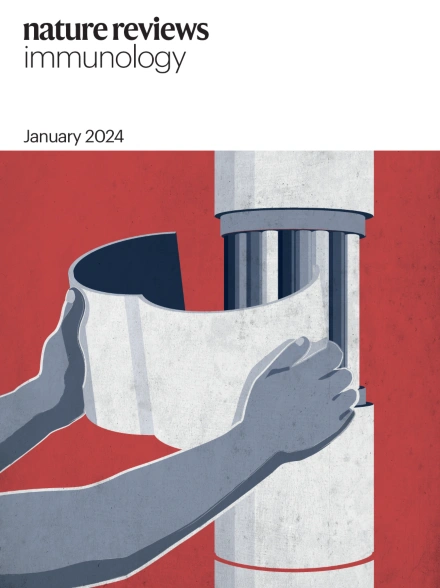重新定义中枢神经系统免疫特权
IF 60.9
1区 医学
Q1 IMMUNOLOGY
引用次数: 0
摘要
中枢神经系统(CNS)与免疫系统有着独特的关系,被称为免疫特权。多年来,人们一直认为免疫特权是由于中枢神经系统与免疫系统的隔离,但最近的研究结果表明,这一理论是有缺陷的,而且存在大量的神经免疫交流,特别是在包围中枢神经系统的边界部位。这些边界部位包括血管周围和蛛网膜下腔、脉络膜丛、脑膜和脉管系统,包括最近发现的脑膜淋巴管。中枢神经系统边界组织与脑脊液有广泛的相互作用,脑脊液作为免疫介质,允许中枢神经系统边界的免疫系统对中枢神经系统实质内的挑战作出反应。中枢神经系统边界组织共同使免疫监视和保护免受感染,同时防止对实质的炎症损伤。更好地理解这两个系统之间的免疫特权机制,将有助于我们获得有效的神经系统疾病免疫疗法。本文章由计算机程序翻译,如有差异,请以英文原文为准。


Redefining CNS immune privilege
The central nervous system (CNS) has a unique relationship with the immune system, referred to as immune privilege. For many years it was thought that immune privilege was due to isolation of the CNS from the immune system, but recent findings have shown that this theory is flawed and that there is substantial neuroimmune communication, particularly at border sites that encase the CNS. These border sites include perivascular and subarachnoid spaces, the choroid plexus, the meninges and the vasculature, including the recently discovered meningeal lymphatic vessels. CNS border tissues have extensive interaction with the cerebrospinal fluid, which acts as an immune mediator, allowing the immune system at the CNS borders to respond to challenges within the CNS parenchyma. Together, CNS border tissues enable immune surveillance and protection against infections while preventing inflammatory damage to the parenchyma. A better understanding of the mechanisms of immune privilege as an accord, as opposed to isolation, between the two systems would help us obtain effective immunotherapies for neurological diseases. In this Perspective, Smyth and Kipnis reappraise the concept of immune privilege in the central nervous system. Although immune privilege was originally thought to involve isolation of the central nervous system from the peripheral immune system, the authors argue that it is instead a special immunological state that involves continuous neuroimmune dialogue.
求助全文
通过发布文献求助,成功后即可免费获取论文全文。
去求助
来源期刊

Nature Reviews Immunology
医学-免疫学
CiteScore
93.40
自引率
0.40%
发文量
131
审稿时长
6-12 weeks
期刊介绍:
Nature Reviews Immunology is a journal that provides comprehensive coverage of all areas of immunology, including fundamental mechanisms and applied aspects. It has two international standard serial numbers (ISSN): 1474-1733 for print and 1474-1741 for online. In addition to review articles, the journal also features recent developments and new primary papers in the field, as well as reflections on influential people, papers, and events in the development of immunology. The subjects covered by Nature Reviews Immunology include allergy and asthma, autoimmunity, antigen processing and presentation, apoptosis and cell death, chemokines and chemokine receptors, cytokines and cytokine receptors, development and function of cells of the immune system, haematopoiesis, infection and immunity, immunotherapy, innate immunity, mucosal immunology and the microbiota, regulation of the immune response, signalling in the immune system, transplantation, tumour immunology and immunotherapy, and vaccine development.
 求助内容:
求助内容: 应助结果提醒方式:
应助结果提醒方式:


